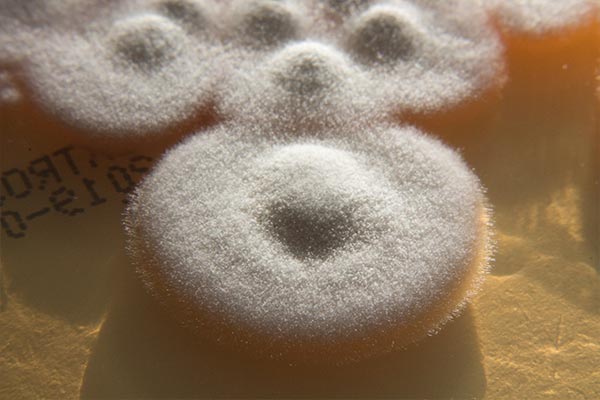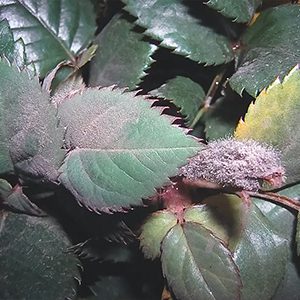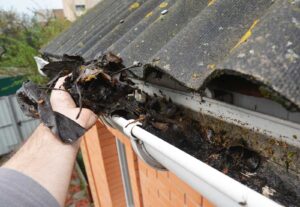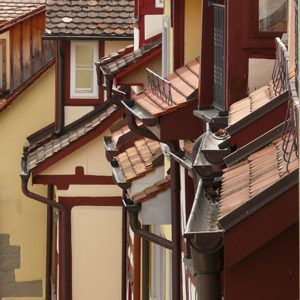5 Common Household Molds and Getting Rid Of Them
Mold is one of those facts of life that most everyone has to deal with from time to time. Either because of a forgotten fruit in the refrigerator or particularly humid outdoors, everyone is confronted with it and has to get rid of mold. While we can’t do much for the forlorn strawberry in the back corner of the icebox, we can talk about molds commonly seen on the exterior of your home. Household molds like:
- Acremonium, a.k.a. “Orange Mold”
- Stachybotrys chartarum, a.k.a. “Black Mold”
- Alternaria, a.k.a. “Leaf Spot”
- Lichens, a.k.a. “Iceland Moss”
- Aspergillus, a.k.a. “Black Mold”
- Ulocladium, a.k.a. “Botrytis” and “Black Mold”
Keep reading to learn more about these common types of household molds and how to recognize them.
1. Acremonium, a.k.a. “Orange Mold”

This particular mold used to go by a different name, cephalosporium. Outside of the home, it’s typically found in soil and decaying matter, like rotting mushrooms. Unless you forage for fungi or are gardening, you may not encounter it outside of your home. But, you still need to know about this potentially dangerous mold.
How to Recognize Acremonium
Despite often being referred to as “orange mold” it’s actually gray-white or a dusty rose color and looks velvety or cotton-like. For children or other tactile individuals, it may be tempting to touch. It often can be found growing with Stachybotrys, also known as “black mold”
Where to Look
Acremonium needs very wet conditions to thrive, but not too hot. Water leaks around sinks, air conditioning units, and a garden spout on a shady side of the house or other similar conditions might be an ideal breeding ground for acremonium.
Health Risks Associated with Acremonium
There are about 100 species in the acremonium spp, but not all of them pose a danger to humans and animals. About six species can cause infections on the skin and nails, in the eyes, internal infections, and osteomyelitis, which is inflammation of the bone marrow. Additionally, arthritis and cerebritis have been reported as well, making the symptoms range from mildly irritating, to dementia-like symptoms. While some of these may be minor, some are difficult to treat and it’s best to take preventative measures.
Surprisingly, cephalosporins, a type of antibacterial medication, were derived from this family of pathogens.
2. Stachybotrys chartarum, a.k.a. “Black Mold”

Perhaps one of the more infamous molds on our list, stachybotrys is what people most commonly call black mold or “toxic black mold.” Outside of the home and outdoor living area, stachybotrys can be found in many different places. For example, a lake and a particularly humid day or two can create the perfect conditions for stachybotrys to germinate and grow. From there even if the water level and humidity drops, this mold can keep going. In nature, it’s very useful for breaking down decaying matter.
How to Recognize Stachybotrys
This mold is typically green or a very deep, dark green in color—hence being called black mold. It can even have grayish-white strands depending on the environment it’s growing in, and numerous other molds look quite similar to it. Identification is difficult without testing, but fortunately, mold testing kits for common types of household molds are easily found online and in stores.
Where to Look
Bathrooms, kitchens, outdoor water hoses and faucets, rain barrels, and any place where water might be sitting in a warmer area may harbor stachybotrys chartarum. Keep in mind that it doesn’t have to be hot and humid all the time, just long enough for this common household mold to germinate and get a foothold.
Health Risks Associated with Stachybotrys
Despite media hype, stachybotrys chartarum isn’t much more dangerous than other types of common household molds. That being said, it can be dangerous to those with respiratory conditions and when it comes to ingesting black mold in a high enough concentration, it can become a more serious problem.
3. Alternaria, a.k.a. “Leaf Spot”

Common worldwide, this mold is sometimes called brown spot or blight, fruit rot, leaf spot, or storage rot. It’s frequently the cause of wasted fruits and vegetables both in the home and, in a more detrimental way, crops.
How to Recognize Alternaria
When examining outdoor and indoor plants, look for imperfect round and club-shaped spores that frequently appear in a chain. Some species of alternaria almost look like a brown bruise on the leaves of plants with the center being the deepest brown or gray in appearance.
Where to Look
While this common type of household mold is mostly seen on plants, it can survive and thrive in any moist environment. Much like the molds we’ve listed above, this one isn’t overly picky about where it germinates and grows.
Health Risks Associated with Alternaria
It’s more or less impossible to avoid exposure to alternaria. From 1998 to 1999, the National Survey of Lead and Allergens in Housing (NSLAH) sampled over 1,000 homes and found that 95-99% of dust samples contained alternaria. For most people, it’s a mild allergic reaction, if any at all, and the mold doesn’t pose as big of a threat to healthy individuals.
For immunocompromised individuals, however, there is some evidence to suggest that it can contribute to infections.
4. Lichens, a.k.a. “Iceland Moss”

Technically, lichen isn’t a mold. It isn’t moss, either despite how it looks. Lichen is actually a mutually beneficial partnership between algae and fungi. The algae provide sustenance for the fungi, and the fungi help the algae survive in an environment that it otherwise wouldn’t. In nature we often see it growing alongside moss and simply mistake it for another kind, or we see its leafy growth on trees. Some people even promote its growth in terrariums or on their landscape.
How to Recognize Lichen
How lichen looks depends on the fungi and algae that it is composed of and it can vary wildly. For example, lichen can be flat and leafy, shaped somewhat like coral, a cup, or a mound of soft feathers. Or, they can look like a leafy patch over a surface. While a pretty addition on some parts of a property, it’s a potentially damaging and costly surface covering for your roof and easier to simply take preventative measures.
Where to Look
Lichen is very common in nature and around the exterior of your home. Chances are you’ve picked it off of trees, like the one pictured above, or off of rocks in the form of colorful crusts. When it comes to the home and situations where you don’t want lichen to thrive, watch the roof and decking; lichen traps moisture, resulting in damage or possibly a slipping hazard if it is growing on a deck.
Health Risks Associated with Lichen
Though often lichen is harmless to humans and animals, some lichen produces toxins that can cause liver damage if ingested. For the most part, however, instances of lichen-related poisoning seem to be restricted to larger, ingested doses.
5. Aspergillus, a.k.a. “Black Mold”

Despite having the same common name, aspergillus isn’t the same as stachybotrys. It commonly contaminates food, like onions, and is also seen in roots, stems, and even the internal features of plants, fruits, and vegetables.
How to Recognize Aspergillus
This type of common household mold is easily recognized—at least when it’s on a vegetable. Rot, like on this onion, or in the internal part of the fruit or vegetable is very likely aspergillus. On the exterior of your home and around windows, however, it may be harder to distinguish from other dark-colored molds.
Where to Look
As mentioned above, it’s common on fruits, vegetables, and plants. It’s also common in other areas that are sufficiently moist and humid, making bathrooms, kitchens, outdoor water faucets, and anywhere where a water leak may facilitate its growth.
Health Risks Associated with Aspergillus
There are over 200 species in the aspergillus family of molds and few of them are dangerous to humans. Those that are, however, are very common and sometimes potentially deadly. For certain immunocompromised populations, infections caused by one specific species, A. fumigatus, can easily result in death. Most healthy individuals only experience mild irritation, but those with asthma or allergies may experience more severe symptoms.
6. Ulocladium, a.k.a. “Botrytis” and “Black Mold”

This type of household mold has numerous species, but the two most common ones are Ulocladium botrytis and Ulocladium chartarum. Originally U.chartarum was an Alternaria, like the leaf spot we talked about above, but was reclassified in the 1960s. U.botrytis is one of the numerous threats to gardeners and greenhouses
How to Recognize Ulocladium
Ulocladium chartarum is commonly called “black mold” and can grow with other black molds, making it harder to differentiate from the numerous common types of dark molds. Ulocladium botrytis, on the other hand, can be easier to spot due to its dusty appearance and appearance on plants.
Where to Look
Plants can play host to U. botrytis while building materials damaged by water, such as drywall and carpet, can host ulocladium chartarum. Like other common molds around the house, look for humid areas where water is sitting or has been in the recent past, and for signs of water damage.
Health Risks Associated with Ulocladium
In the past, species in the ulocladium genus haven’t been strongly associated with health problems for humans, but at least one instance has been reported where ulocladium was responsible for an infection in a 35-year-old woman. For months she had been experiencing symptoms of allergies, although when she went in for medical attention, the symptoms proved resistant to treatment. Ultimately, the patient had to undergo a medically necessary Rhinoplasty—a nose job—to remove the mold.
Preventing the Growth of Common Household Molds
The best way to ensure that your property remains damage-free and your health uncompromised is to prevent mold. Keep in mind that outside your home, mold is a simple fact of life and unavoidable, but you can lessen the chances of inhaling or ingesting spores by keeping up with the interior and exterior of your home.
Here are some tips on how to prevent common household molds:
Measure the humidity. Purchase a hygrometer ($20 or less on Amazon) and ensure that your home is below 60% when the device reads it. The EPA recommends between 30% to 60% to discourage mold and other allergens, like cockroaches and dust mites.
- Provide more ventilation. Either with exhaust fans or open windows, ensure that your home is well ventilated. Air can hold a lot of moisture, which contributes to creating an environment where household molds can thrive and be inhaled by the residents of the home.
- Keep the exterior clean. Clogged gutters can result in damage to your home, but they can also be a breeding ground for common types of mold in the warmer, humid months. Maintaining them and being vigilant about clean gutters—even with gutter guards—can help protect your health. Additionally, pressure washing the property to remove organic buildup can minimize mold growth.
- Clean up spills. Whether it’s sitting water outside or a spill indoors, cleaning up sitting water will make the exterior and interior of your property a less appealing place for common molds. Dripping outdoor faucets, rain barrels, and condensation from air conditioning units can all be contributing factors to mold growth.
It’s also important to keep in mind that you may do all of these things and still find mold inside or outside of your property. Mold is a naturally occurring part of the world and it isn’t always possible to prevent 100%.
Getting Rid of Mold
If mold does inevitably develop, there are some techniques you can use to get rid of it safely. First and foremost, we recommend hiring a professional. Removing mold from the exterior of your home is fairly straightforward when using a professional. Pressure washing or soft washing, when done by professionals, is typically thorough enough to get rid of any mold and possibly discourage growth later, depending on the additives used. Professionals can also clean windows, inspect the seals and surrounds for signs of damage, and remove mold that might be harder to get to with typical home cleaning.
Getting Rid of Common Household Molds Inside
Whereas a professional window washing or pressure washing service can get rid of mold outside, mold remediation experts are a good idea inside. It can sometimes be a costly investment, but mold spores are minuscule, travel easily, and can remain dormant on a surface until the right circumstances allow them to germinate. Additionally, experts are able to find all types of household mold in places that property owners may not think to look.
It’s also important to evaluate the professionals you’ll be bringing into your home. Our blog post Hiring an Exterior Window Cleaning Pro discusses the questions you should ask window cleaning professionals, but these questions apply to any cleaning company that you’ll have on your property and will help you evaluate their credibility.
DIY Techniques for Mold Removal
Ultimately best to hire professionals, but the cost of mold removal inside can be several thousand dollars. Pressure washing tends to be affordable comparatively, but for temporary fixes to control mold indoors until a professional service can be secured, here are some tips:
-
Wear Protective Gear.
When cleaning up any kind of mold, wear a mask that fits securely on your face to prevent inhaling spores. Also, wear goggles that do not feature any gaps. Certain types of household molds, like the first black mold on our list, can cause eye infections. Additionally, wear a protective covering for your skin and clothes.
-
Secure pets and family members.
Ensure that loved ones of all kinds are safely away from the area and cannot breathe in the spores or cleaning agents you’ll be using.
-
Use Bleach.
If using bleach, be sure that you do not mix it with other household chemicals. Chloramine gas, which the UN categorizes as a chemical weapon, is one possible result and can be lethal. Also, keep in mind that bleach may stain some surfaces.
-
Use scrub brushes and cloths.
For surfaces that can be damaged by scrubbing, use a cloth. In both cases, however, it’s important to brush off as much mold as possible before wetting—not soaking—the surface and cleaning it. We don’t advise trying to reuse the tools.
-
Provide ventilation.
Using open windows and fans, ventilate the area very well once it’s done. While exhaust fans are an option here, keep in mind that any spores that survive the bleach may find your ventilation system hospitable.
Frequently asked questions about the most common types of household molds.
Household molds are common the world over, but especially here in the southern part of the United States. Here are some of the most common questions we see regarding household molds.
How do I know what kind of mold I have?
Some molds can be easier to identify, but many species of mold look incredibly similar or indistinguishable to the naked eye. The best way to identify what kind of mold is growing in your home is by ordering a test kit and sending it to a laboratory. Results are typically quick and can help inform property owners about next steps.
How many types of house mold are there?
There are more than 100,000 types of mold, all of which can be found both indoors and outside. While most of them are benign or beneficial, some of them are toxic to humans, animals, and plants.
What does toxic house mold look like?
Toxic household molds may look furry or sooty and come in a variety of colors from gray to orange or black. It may also appear wet or slimy. Ultimately, a test is the best way to identify mold. If unsure, it’s best to avoid the area and hire a professional.
Should I worry about mold in my basement?
Basements are particularly prone to mold due to the damp, dark nature of the area and damage caused by things like sitting water due to clogged gutters. Because of this, household molds can easily develop in the basement of homes and, if left unchecked, can be very difficult to get rid of.
Is it safe to live in a house with mold in the basement?
Most people are not likely to experience more than mild allergy symptoms when it comes to mold. For those that are immunocompromised, living with household mold can be a threat to their health. Technically about 3% of Americans meet the definition of immunocompromised, but allergies and asthma are also indicative of an abnormal immune system.
Will a dehumidifier help with mold in the basement?
Dehumidifiers may help inhibit the growth of mold, but ultimately it’s important to ensure that the environment in the basement is inhospitable for common household molds in order to prevent growth.
Would an air purifier help with mold?
Like a dehumidifier, an air purifier can help prevent mold from spreading. It will cleanse the air of mold spores, ensuring that they cannot germinate in other parts of the home, or inside who live there. It is important, however, to take preventive measures to ensure that mold doesn’t develop to begin with.
What is the most common mold in Florida homes?
Aspergillus, the fifth mold on our list, is the most common household mold found in Florida. It has over 180 species, many of which have their own unique colors and features.


